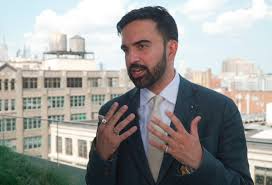‘Billionaires shouldn’t exist’: NYC mayoral candidate Zohran Mamdani proposes to hike taxes on ‘white neighbourhoods’

In a bold and controversial move, New York City mayoral hopeful Zohran Mamdani has sparked national debate by advocating for a significant restructuring of the city’s tax system—one that would increase property taxes in affluent, predominantly white neighborhoods while easing the burden on lower-income, racially diverse communities. While Mamdani’s supporters praise his economic justice stance, critics warn the proposal may cross legal boundaries and deepen racial divisions.
A Socialist Agenda for the 21st Century
Zohran Mamdani, a Democratic Socialist and current State Assemblymember from Queens, has made it clear that his candidacy is rooted in a platform of economic redistribution, equity, and a reimagining of how wealth is shared in New York City.
At the center of his plan is a sweeping $10 billion tax proposal aimed at funding social programs like free public transit, universal child care, rent freezes, and public grocery stores. To achieve this, Mamdani proposes:
- A 2% surtax on New Yorkers earning over $1 million annually.
- Raising corporate taxes from approximately 7.25% to 11.5%.
- A property tax overhaul targeting “richer and whiter neighborhoods.”
Mamdani defends this approach by pointing to longstanding property tax inequalities that have historically benefited wealthier areas like Manhattan’s Upper East Side or Park Slope in Brooklyn. He argues that lower-income communities often pay a higher percentage of their property’s market value in taxes, despite owning homes of far less value.
“Billionaires Shouldn’t Exist”
The phrase that captured the most attention during Mamdani’s recent media appearances was blunt:
“Billionaires shouldn’t exist.”
He elaborated by stating that no individual should amass such immense wealth while others in the same city struggle to afford rent, food, or transportation. He emphasized this wasn’t a personal attack on any billionaire but rather a moral position on wealth hoarding in an era of widespread inequality.
While Mamdani acknowledged he’s open to collaborating with wealthy individuals on city projects, his fundamental belief is that extreme wealth accumulation contributes to systemic injustice—and the tax code is a major enabler.
Targeting “Whiter Neighborhoods”: What Does That Mean?
The most contentious element of Mamdani’s platform is his explicit call to raise taxes on what he calls “whiter neighborhoods“—a term that has ignited backlash from legal experts, civil rights advocates, and political opponents.
Critics, including attorney Harmeet Dhillon, argue that targeting policies based on race or racial demographics could violate federal anti-discrimination laws. Dhillon has suggested that Mamdani’s comments warrant scrutiny from the Department of Justice.
In response, Mamdani insists that his use of racial terminology is not an attack on any group, but rather a descriptive acknowledgment of the demographics that have historically benefited from favorable property tax laws.
“We’re not taxing people because they’re white—we’re taxing neighborhoods that have been historically undertaxed and are disproportionately white,” Mamdani said during a campaign rally in Brooklyn.
Still, the optics of race-based framing in public policy remain controversial, particularly in a city as diverse—and as racially sensitive—as New York.
Political and Public Reactions
Governor Kathy Hochul has already pushed back against Mamdani’s plans, warning that higher taxes could drive wealthy residents and corporations out of the state—a fear echoed by financial leaders on Wall Street.
Political analysts note that Mamdani’s proposals may gain traction in progressive circles, particularly among younger voters and working-class communities burdened by New York’s rising cost of living. However, state-level approval is needed for major tax reforms, and it’s unclear whether his ideas would survive Albany’s legislative process.
The real test may lie with New York’s voters. In a city increasingly divided between luxury real estate and affordable housing shortages, Mamdani’s message of redistribution and equity resonates with some and alarms others.
Legal and Ethical Questions
While Mamdani’s supporters argue that he is addressing structural inequity, legal scholars raise red flags about targeting any group—directly or indirectly—based on race or ethnicity.
The U.S. Constitution prohibits race-based discrimination by public officials, and any attempt to enact tax laws that explicitly or implicitly disadvantage certain racial groups could result in legal challenges.
Yet, Mamdani’s team argues that the proposed changes are not racial in implementation, only in outcome due to existing demographics. Whether this distinction holds up in court remains to be seen.
Can NYC Afford This Shift?
Beyond the controversy, the economic question looms large: can New York City afford to not try something radical?
Rising rents, stagnant wages, homelessness, and transit decay have left many New Yorkers frustrated with the status quo. Mamdani believes that his bold vision is a realistic pathway to a fairer city, and that taxing the ultra-wealthy and correcting tax inequities are necessary steps.
His campaign may yet reshape the conversation about what fairness and equality mean in America’s largest city.
Conclusion
Zohran Mamdani’s tax proposal is more than just a campaign plank—it’s a referendum on how New York City should define justice, wealth, and fairness in the 21st century. Whether you see it as a courageous correction or a misguided provocation, the debate it has sparked underscores just how central economic and racial equity have become in modern urban politics.






